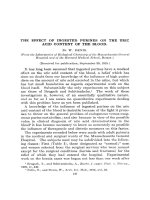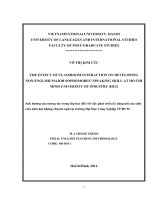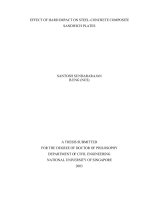Effect of leaf characteristics on different brinjal genotypes and their correlation on insects pests infestation - Trường Đại học Công nghiệp Thực phẩm Tp. Hồ Chí Minh
Bạn đang xem bản rút gọn của tài liệu. Xem và tải ngay bản đầy đủ của tài liệu tại đây (254.54 KB, 6 trang )
<span class='text_page_counter'>(1)</span><div class='page_container' data-page=1>
<i><b>Int.J.Curr.Microbiol.App.Sci </b></i><b>(2017)</b><i><b> 6</b></i><b>(11): 3752-3757 </b>
3752
<b>Original Research Article </b>
<b>Effect of Leaf Characteristics on Different Brinjal Genotypes and </b>
<b>their Correlation on Insects Pests Infestation </b>
<b>S.P. Bindu* and A. Pramanik </b>
Department of Agricultural Entomology, Bidhan Chandra Krishi Viswavidyalaya,
Mohanpur - 741 252, West Bengal, India
<i>*Corresponding author </i>
<i><b> </b></i> <i><b> </b></i><b>A B S T R A C T </b>
<i><b> </b></i>
<b>Introduction </b>
Brinjal or eggplant, <i>Solanum melongena</i> L. is
one of the important vegetable crops grown in
India and other parts of the world. Insect pests
are the main constraint in the successful
cultivation of brinjal. Among them,
leafhopper and whitefly are cosmopolitan in
distribution and are found wherever brinjal is
grown. The use of resistance genotypes is
familiar as the imperative tool for the
bio-intensive pest management system. The
morphological and physical characteristics of
plants and fruits are associated with attraction,
feeding and oviposition of the insect pests.
Development of varieties resistant to the
insect pests is an important strategy of
integrated pest management (Bhatti <i>et al.,</i>
1976). The identification of biophysical
characteristics from insect resistant varieties
is of most practical significance.
The degree of hair of trichome, on the leaves
occurs in large numbers and plays a vital role
in the plant defense particularly among
phytophagous insects.
Uthamasamy (1985) found that the resistant
varieties had more hairs than susceptible ones.
Keeping in mind the seriousness of attack and
the increasing incidence of the major insect
pests on brinjal a humble attempt has been
undertaken to find out the source of resistance
and correlation of different morphological
plant characteristics of different brinjal
cultivars.
<i>International Journal of Current Microbiology and Applied Sciences </i>
<i><b>ISSN: 2319-7706 Volume 6 Number 11 (2017) pp. 3752-3757 </b></i>
Journal homepage:
The field and laboratory experiments were carried out with twenty-two brinjal varieties
during <i>post–kharif</i> season of 2013-2015 in the Central Research Farm, Gayeshpur, Bidhan
Chandra Krishi Viswavidyalaya. The morphological characteristics of brinjal leaves are
associated with attraction, feeding and oviposition of the insect pests. In 2013-2015
investigation, interaction between jassids incidence and morphological characteristics on
brinjal revealed that the population of jassids, whitefly, shoot and fruit borer, and
epilachna beetles was negatively correlated with leaf thickness and trichomes. The jassids,
whitefly, epilachna beetles population was negatively correlated with leaf area but the
aphid and shoot and fruit borer were positively correlated. Jassids, whitefly and aphids was
negatively correlated with coccinellids predators and spiders while, the population of shoot
and fruit borer and epilachna beetles showed positive correlation.
<b>K e y w o r d s </b>
Brinjal, Leaf area,
Trichome, Leaf
thickness.
<i><b>Accepted: </b></i>
26 September 2017
<i><b>Available Online:</b></i>
10 November 2017
</div>
<span class='text_page_counter'>(2)</span><div class='page_container' data-page=2>
<i><b>Int.J.Curr.Microbiol.App.Sci </b></i><b>(2017)</b><i><b> 6</b></i><b>(11): 3752-3757 </b>
3753
<b>Materials and Methods </b>
A fields experiment was carried out during
2013-2015 at Central Research Farm of
Bidhan Chandra Krishi Viswavidyalaya,
Gayeshpur, Nadia, West Bengal. Twenty two
(22) cultivars of brinjal were screened for
their relative susceptibility to major insect
pests. The plot size was 3m × 2.5m with 60cm
and 50cm spacing. The experiment was laid
out in a Randomized block design with three
replications. Ten leaves of almost similar age
from each replication were plucked from each
variety/genotype at peak infestation period of
insect pests. The following observations were
taken for morphological characteristics of
different varieties/cultivars of brinjal: a) Leaf
area (sq. cm) – measured by using
graphpaper, b) Number of trichome on leaf
lamina and midrib – the number of trichome
per sq. cm of leaf of under surface (base,
middle and tip portions) were counted with
the aid of calibrated ocular grid under a
dissecting microscope and c) Leaf thickness
(mm) – the cross section of such leaves at
three different parts of the lamina was taken
and measured using stage and ocular
micrometer. Several morphological characters
of the twenty two varieties of brinjal were
correlated each with the number of major
insects.
<b>Results and Discussion </b>
The morphological characteristics of brinjal
leaves are associated with attraction, feeding
and oviposition of the insect pests. The effect
of leaf morphological characters of brinjal on
different varieties have been recorded during
2013-2015 and presented in Table 1. In the
present study revealed that the mean leaf
thickness in different varieties ranged
between 0.26 to 0.80 mm. The varieties Sada
Jhuri Begun (0.80 mm) was recorded highest
leaf thickness followed by the varieties
Punjab Sadabahar and Garia Begun (0.57
mm).While, the lowest leaf thickness was
observed on the varieties BCB-50 (0.26 mm)
followed by BCB-11(0.27 mm) and 13 BRL-2
(0.29 mm).
The mean leaf area on different brinjal
varieties ranged from 32.35 to 64.20 cm2. The
highest leaf area was observed on the varieties
Muktakeshi (64.20 cm2) at par with each
varieties and followed by 13 BRL-6 (58.30
cm2) and on par with each other. The least
leaf area was found on the varieties 13 BRL-2
(32.35 cm2) and 13 BRL-4 (33.00 cm2). The
mean trichome density on different varieties
ranged between 778.05 and1138.40 per cm2.
The highest trichome density was recorded on
the varieties 12 SPL-BL-7 (1138.40 per cm2)
followed by the varieties 13 BRL-6 (11.4.63
per cm2) but the lowest trichomes density was
observed on the varieties 13 BRL-4 (778.05
per cm2).
The present investigations are in partial
agreement with the finding by Amin <i>et al.,</i>
(2014) who reported that the higher leaf area
(63.53cm2/leaf) and leaf trichome (256.7/25
mm2) had lower shoot and fruit infestation.
Wagh <i>et al.,</i> (2012) also reported that the
mean trichome density of leaf surface
recorded in different brinjal genotypes ranged
from 458.67 to 1192.67 per cm2 and
maximum trichome density was found in less
susceptible genotypes. The earlier results
reported by Naqvi <i>et al., </i>(2008) specify the
trichome density in the range of 550.5 to
1068.5 per cm2, the leaf area ranged
68.8-22.9 cm2 and leaf thickness ranged
0.343-0.157 mm from thirteen (13) brinjal varieties.
<b>Correlation between insect pests of brinjal </b>
<b>with leaf morphological characteristics of </b>
<b>brinjal </b>
</div>
<span class='text_page_counter'>(3)</span><div class='page_container' data-page=3>
<i><b>Int.J.Curr.Microbiol.App.Sci </b></i><b>(2017)</b><i><b> 6</b></i><b>(11): 3752-3757 </b>
3754
correlated with insect pests population, so that
the promising brinjal varieties can be
identified for future benefit. Weekly average
of the screening incidence of insect pests
population during 2013-2014 were analyzed
and correlated on Table 2.
<b>Jassid, </b><i><b>Amarasca biguttula biguttula</b></i>
Interaction between jassids incidence and
morphological characteristics on brinjal
revealed the population of jassids showed
significantly negatively correlated with leaf
thickness (-0.431), while the leaf area (-0.703)
and trichomes density (-0.569) showed
significantly negative correlation. The
variation in population of jassids observed
about 79 % was due to all the leaf
morphological characteristics (Table 2).
According to Naqvi <i>et al., </i> (2008) who
reported that the leaf area, leaf thickness
exerted no effect on leafhopper population,
while trichome density had negative
correlation. However, Giekwad <i>et al., </i>(1991)
reported positive correlation between
thickness of leaf and leaf area with leafhopper
infestation. The most resistant varieties with
longer more numerous and more branched
trichomes and significantly correlated with
leafhopper (Lit and Bernardo, 1990).
<b>Table.1 </b>Morphological leaf characters in different brinjal varieties/ genotypes
<b>Varieties </b> <b>Leaf thickness </b>
<b>(mm) </b>
<b>Leaf area </b>
<b>(cm2) </b>
<b>Trichomes </b>
<b>(density/cm2) </b>
13BRL-1 0.45 48.20 788.45
13BRL-2 0.29 32.35 942.10
13BRL-3 0.46 43.80 852.35
13BRL-4 0.31 33.00 778.05
13BRL-5 0.44 43.80 880.00
13BRL-6 0.51 58.30 1104.63
Punjab Sadabahar 0.57 46.90 993.05
Kashi Taru 0.41 40.00 825.35
12SPL-BL-1 0.31 47.25 877.20
12SPL-BL-2 0.34 41.65 873.50
12SPL-BL-4 0.41 45.70 951.65
12SPL-BL-5 0.48 40.00 871.85
12 SPL-BL-7 0.46 57.95 1138.40
BCB-11 0.27 49.90 793.70
BCB-30 0.49 52.15 874.95
BCB-50 0.26 56.40 832.40
Garia Begun 0.57 44.00 964.80
Sada Jhuri Begun 0.80 43.00 878.60
Muktakeshi 0.52 64.20 814.55
Punjab Round 0.36 40.95 863.20
Punjab Barshati 0.29 40.10 933.45
Makra 0.48 49.25 895.10
<b>SE.m </b> <b>0.06 </b> <b>5.39 </b> <b>67.98 </b>
</div>
<span class='text_page_counter'>(4)</span><div class='page_container' data-page=4>
<i><b>Int.J.Curr.Microbiol.App.Sci </b></i><b>(2017)</b><i><b> 6</b></i><b>(11): 3752-3757 </b>
3755
<b>Table.2 </b>Correlations between insect pests with leaf morphological characteristics of brinjal
<b>Insect pests/ </b>
<b>Natural enemies </b>
<b>Leaf </b>
<b>thick </b>
<b>Leaf </b>
<b>area </b> <b>Trichomes R</b>
<b>2</b>
<b>Regression equation </b>
<b>Jassids </b> -.431* -.703** -.569** 0.791 Y=7.88 -.01X1 -.05X2 - 1.21X3
<b>Whitefly </b> -.352 -.051 -.356 0.696 Y=-4.11 -.02X1 -.81X2 - 4.82X3
<b>Aphid </b> -.371 .041 -.019 0.825 Y=-1.29 -.51X1 - 1.09X2 - 2.81X3
<b>Shoot and fruit borer </b>-.190 .033 -.204 0.703 Y=-3.21 - 2.01X1 -.85X2 - 2.19X3
<b>Leafrollers </b> -.101 .030 -.304 0.731 Y=-2.82 - 1.08X1 - 2.19X2 -1.81X3
<b>Epilachna beetles </b> -.307 -.086 -.447* 0.400 Y=.85 - 0.29X1 - 0.14X2 - 2.81X3
* Significant at the 0.05 level (2-tailed), **significant at the 0.01 level (2-tailed).
<b>Table.3 </b>Correlations between insect pests with their natural enemies of brinjal
<b>Insect pests/ </b>
<b>Natural enemies </b> <b>Coccinellid </b> <b>Spider </b> <b>R</b>
<b>2</b>
<b>Regression equation </b>
<b>Jassids </b> -0.208 -0.409* 0.780 Y= 7.88 -.05X1 - 2.02X2
<b>Whitefly </b> -0.032 -0.197 0.705 Y= -4.11 -.08X1 - 3.05X2
<b>Aphid </b> -0.061 -0.202 0.830 Y= -1.29 -.05X1 - 1.15X2
<b>Shoot and fruit borer </b>.439* -0.026 0.690 Y= -3.21 -.09X1 -.04X2
<b>Leafrollers </b> 0.421 -0.097 0.721 Y= -2.82 - 2.03X1 -.09X2
<b>Epilachna beetles </b> .616** 0.154 0.390 Y=.85 - 3.12X1 -.07X2
* Significant at the 0.05 level (2-tailed), **significant at the 0.01 level (2-tailed).
<b>Whiteflies, </b><i><b>Bemisia tabaci</b></i>
In 2013-2014, interaction studies between the
whiteflies incidence and morphological
characteristics on brinjal showed that the leaf
thickness, leaf area and trichomes density had
negatively non-significant correlation with
whiteflies population.
The variation in population of whiteflies
observed about 69 % was due to all the leaf
morphological characteristics (Table 2). The
present findings are in agreement with Naqvi
<i>et al., </i>(2008) who reported that the leaf area
had positive significant effect on whitefly
population, whereas leaf thickness, trichome
density had no significant effect. Soundarajan
and Baskaran (2001) reported negative
significant correlation between trichome
density and whitefly population are in
supportive with the present findings.
<b>Aphids, </b><i><b>Aphis gossypii</b></i>
</div>
<span class='text_page_counter'>(5)</span><div class='page_container' data-page=5>
<i><b>Int.J.Curr.Microbiol.App.Sci </b></i><b>(2017)</b><i><b> 6</b></i><b>(11): 3752-3757 </b>
3756
<b>Brinjal shoot and fruit borer, </b><i><b>Leucinodes </b></i>
<i><b>orbonalis</b></i>
The population of brinjal shoots and fruit
borer revealed that the leaf thickness (-0.190)
and trichomes density (-0.204) was negatively
non-significant correlation but the leaf area
(+0.033) was found positively non-significant
correlated. The variation in population of
shoot and fruit borer observed about 70 %
was due to all the leaf morphological
characteristics (Table 2).Wagh <i>et al.,</i> (2012)
observed that the shoot thickness showed
strong and positive correlation (r = 0.632) in
relation to incidence of shoot borer. Javed <i>et </i>
<i>al., </i>(2011) reported that strong and negative
correlation between trichome density and
infestation of <i>L. orbonalis</i> which are in
agreement with present study.
<b>Leaf roller,</b><i><b> Eublemma olivacea</b></i>
During 2013-2014, the leaf roller population
showed negatively non-significant correlation
with the leaf thickness and trichomes density.
While, the leaf area was positive correlated.
The variation in population of leaf roller
observed about 73 % was due to all the leaf
morphological characteristics (Table 2).
<b>Epilachna </b> <b>beetles,</b> <i><b>Epilachna </b></i>
<i><b>vigintioctopunctata</b></i>
The epilachna beetles population was
negatively non-significant correlated with the
leaf thickness (-0.307) and leaf area (-0.086)
but negatively significantly correlated with
trichomes density (-0.447). The variation in
population of epilachna beetles observed
about 40 % was due to all the leaf
morphological characteristics (Table 2).Wagh
<i>et al.,</i> (2012) reported that the maximum
trichome density was found in less susceptible
genotypes. Ishaque and Chowdahary’s (1984)
supported that they had high positive
correlation between the leaf area of the
varieties and the degree of susceptibility.
They also found less susceptible varieties had
thick and closely placed leaf trichome.
<b>Correlation between insect pests with their </b>
<b>natural enemies of brinjal</b>
<b>Coccinellid predators </b>
The population of coccinellid predators was
negatively correlated with the population of
jassids (-0.208), whiteflies (-0.032) and aphid
incidence (-0.061). While brinjal shoot and
fruit borer (+0.439) and epilachna beetle
(+0.616) were significantly positively
correlated. But, the population of leafroller
(+0.421) was positively non-significant
correlated (Table 3).
<b>Spider </b>
In 2013-2014, the spiders showed negatively
significant correlation with jassids but the
whiteflies, aphids, brinjal shoot and fruit
borer and leafroller incidences was negatively
non-significant correlated. While, epilachna
incidence (+0.154) was positively
non-significantly correlation with the population
of spiders (Table 3).
The variation in population of insect pests of
brinjal observed about 39% to 83% was due
to their natural enemies. According to Vishav
<i>et al.,</i> (2014) supported that the conservation
of natural enemies will help in suppressing
the <i>E. vigintiocpunctata</i> population in brinjal.
Kalaichelvi (2008) reported that the natural
enemies population was found to have direct
correlation with sucking pest population.
<b>References </b>
</div>
<span class='text_page_counter'>(6)</span><div class='page_container' data-page=6>
<i><b>Int.J.Curr.Microbiol.App.Sci </b></i><b>(2017)</b><i><b> 6</b></i><b>(11): 3752-3757 </b>
3757
brinjal varieties/lines influencing brinjal
shoot and fruit borer infestation.
<i>International Journal of Economic </i>
<i>Plants</i>.1 (1):001-008.
Bhatti, M. A., M. Saeed, N. Chatta and S.
Iqbal. 1976. Hostplant resistance and
importance to insect population
suppression in cotton crop. <i>Proc. Cott. </i>
<i>Prod</i>. Seminar, ESSO, Pak. Fertilizer
Co. Ltd. pp. 132-142.
Giekwad, B. P.; Darakar, K. S. and Chavan,
U. D. 1991.Varietal reaction of eggplant
against leafhopper. <i>Journal </i> <i>of </i>
<i>Maharashtra Agricultura University</i>.
16: 354-356.
Isahaque, N. M. M. and Chaudhuri, R. P.,
1984.Larval development behavior of
<i>Leucinodes orbonalis </i>Guen. reared on
some brinjal varieties. <i>Journal of </i>
<i>Research, </i> <i>Assam </i> <i>Agricultural </i>
<i>University</i>.5: 93-97.
Javed, H.; Ata-ul-mohsin; Aslam, M.; Naeem,
M.; Amjad, M. and Mahmood, T.
2011.Relationship between
morphological characters of different
aubergine cultivars and fruit infestation
by <i>Leucinodes </i> <i>orbonalis </i> Guenee.
<i>Pakistan Journal of Botany</i>.43 (4):
2023-2028.
Kalaichelvi, K. (2008). Effect of plant spacing
and fertilizer levels on insect pests in
BT cotton hybrids.<i>Indian Journal of </i>
<i>Entomology</i>. 70(4): 356-59.
Lit,M.C. and Bernardo,E.N.1990.Mechanism
of resistance of eggplant (<i>Solanum </i>
<i>melongena</i> Linn.) to the cotton
leafhopper, <i>Amrasca biguttula</i> (Ishida)
II. Morphological and biochemical
factors associated with resistance.
<i>Philippine Journal of Crop Science</i>.15
(2): 79-84.
Naqvi, A.R; Pareek, B.L; Nanda, U.S. and
Mitharwal, B.S. 2008. Leaf morphology
and biochemical studies on different
varietie of brinjal in relation to major
sucking insect pests. <i>Indian Journal of </i>
<i>Plant Protection</i>.36 (2): 245-248.
Soundarajan R. P. and Baskaran P. 2001.
Mechanism of resistance in brinjal
(<i>Solanum melongena</i>L.) to whitefly,
<i>Bemisia </i> <i>tabaci</i> (<i>Gennadisus</i> L.).
<i>Madras Agricultural Journal.</i>
88:657-659.
Uthamasamy, S. 1985. Influence of leaf
hairiness on the resistance of bhendi or
lady,s finger, <i>Abelmoschus </i>
<i>esculentus</i>(L.) Moench, to the
leafhopper, <i>Amrasca devastans </i>(Dist.).
<i>Trop. Pest Manag</i>. 31:294-295.
Vishav, V. S. J.; Hafeez, A.; Devinder, S.;
Kuldeep, S. and Suheel, A. G. 2014.
Natural enemies associated with
<i>Epilachna vigintiopunctata </i> (F.) on
brinjal. <i>Indian </i> <i>Journal </i> <i>of </i>
<i>Entomology.</i>76 (4):356-358.
Wagh, S.S; Pawar, D.B; Chandele, A.G. and
Ukey, N.S. 2012. Biophysical
mechanisms of resistance to brinjal
shoot and fruit borer, <i>Leucinodes </i>
<i>orbonalis </i> Guenee in brinjal. <i>Pest </i>
<i>Management </i> <i>in </i> <i>Horticulture </i>
<i>Ecosystem</i>.18 (1):54-59.
<b>How to cite this article: </b>
Bindu, S.P. and Pramanik, A. 2017. Effect of Leaf Characteristics on Different Brinjal
Genotypes and their Correlation on Insects Pests Infestation. <i>Int.J.Curr.Microbiol.App.Sci.</i>
</div>
<!--links-->
Ôn tập triết học cao học trường đại học nông nghiệp hà nội
- 42
- 387
- 0








